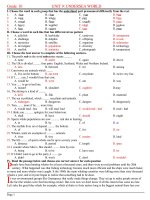Unit 9 undersea world
Bạn đang xem bản rút gọn của tài liệu. Xem và tải ngay bản đầy đủ của tài liệu tại đây (784.55 KB, 22 trang )
WARM- UP
1. Can you name the sea animal in this picture?
Sperm whale
WARM- UP
1. Can you name the sea animal in this picture?
Dolphin
WARM- UP
2. Do you know anything about them?
Sperm whale
Dolphin
Tuesday January 12th, 2016
Unit 9: cont’
D. Writing
* New words:
1. carnivore (n): / ‘ka:nivɔ:/
động vật ăn thịt
* New words:
1. carnivore (n): / ‘ka:nivɔ:/
động vật ăn thịt
* New words:
1. Carnivore:/ ‘ka:nivƆ:/ (n)
động vật ăn thịt
2. Gestation/ dʒes'tei∫n / (n)
thời kì thai nghén
3. Offspring /'ɔ:fspriη /(n)
con
* New words:
1. Carnivore:/ ‘ka:nivƆ:/ (n)
động vật ăn thịt
2. Gestation/ dʒes'tei∫n / (n)
thời kì thai nghén
3. Offspring /'ɔ:fspriη /(n)
con
* New words:
1. Carnivore:/ ‘ka:nivƆ:/ (n) động vật ăn thịt
2. Gestation/ dʒes'tei∫n / (n) thời kì thai nghén
3. Offspring /'ɔ:fspriη /(n)
4. Life span /laif spæn/ (n):
con, con vật nhỏ
tuổi thọ
= (the length of time that s.o /st is likely to live):
5. Habitat / 'hæbitæt /(n): môi trường sống
= (the natural environment of plants or animals)
6. Entrapment/ in'træpmənt / (n): bị mắc bẫy
7. calf (n):
thú con (cá voi con, cá heo,….)
(số nhiều: calves)
* New words:
1. Carnivore:/ ‘ka:nivƆ:/ (n) động vật ăn thịt
2. Gestation/ dʒes'tei∫n / (n) thời kì thai nghén
3. Offspring /'ɔ:fspriη /(n)
4. Life span /laif spæn/ (n):
con, con vật nhỏ
tuổi thọ
= (the length of time that s.o /st is likely to live):
5. Habitat / 'hæbitæt /(n): môi trường sống
= (the natural environment of plants or animals)
6. Entrapment/ in'træpmənt / (n): bị mắc bẫy
7. calf (n):
thú con (cá voi con, cá heo,….)
(số nhiều: calves)
II. Task 1: Read the description of the sperm whale
and then complete the table that follow:
Sperm whale
Range & habitat
SIZE
Feeding habits
Offspring
Life span
Special feature
Conservation concerns
All oceans
Prefer waters with high squid populations
Male: 18 metres in length; 54,000 kg in weight
Female: 12 metres in length; 17,000 kg in weight
Carnivores; eat mainly squid
Eat up to 1.500kg of food daily
Give birth to one calf every 5 to 7 years
Gestation period: 14 – 19 months
Up to 60 or 70 years
Biggest animals that have teeth on Earth
Have the largest brain of all mammals
At risk due to hunting and accidental fishing
net entrapment
II. Task 1: Read the description of the sperm whale
and then complete the table that follow:
Sperm whale
Range & habitat
SIZE
Feeding habits
Offspring
Life span
Special feature
Conservation concerns
All oceans
Prefer waters with high squid populations
Male: 18 metres in length; 54,000 kg in weight
Female: 12 metres in length; 17,000 kg in weight
Carnivores; eat mainly squid
Eat up to 1.500kg of food daily
Give birth to one calf every 5 to 7 years
Gestation period: 14 – 19 months
Up to 60 or 70 years
Biggest animals that have teeth on Earth
Have the largest brain of all mammals
At risk due to hunting and accidental fishing
net entrapment
Format of a descriptive paragraph
1.Topic sentence: (Câu chủ đề)
what you want to describe about
( provides the name of something
you are going to write about and
its most remarkable feature)
Underline the topic sentence (câu
chủ đề) and concluding sentence
2.Supporting
sentences:
(câu kết) in the
paragraph.
(Câu phát triển ý) describe the
something’s details
3.Concluding sentence: (Câu kết)
problems , concerns that you want
to write
Sperm whales are the biggest animals on Earth
that have teeth. They are carnivores, which
means they eat meat. Although sperm whales can
be found in all oceans, they prefer the waters
with high squid populations, which are their
main diet. A sperm whale can eat up to 1,500 kg
of food each day. Sperm whales are big animals.
The male can grow up to18 metres long and
weigh up to 54,000kg while the females are a bit
smaller with a length of 12 metres and a weight
of 17,000kg. A female sperm whale gives birth to
one calf every five to seven years after a
gestation period of fourteen to nineteen months.
The life span of sperm whales can be up to sixty
or seventy years. It is interesting to know that
they also have the largest brain of mammals.
Sperm whale populations are at risk due to
hunting and their accidental entrapment in
fishing nets.
III. Task 2:
Write a paragraph that describes the facts and figures
provided in the table. Begin your writing with “ Dolphins
are not fish, they are mammals that……..”
DOLPHIN
RANGE &
HABITAT
Oceans worldwide
Prefer costal waters and bays
SIZE
Smallest: about 50 kg and 1.2 m
Largest: up to 8,200 kg and 10 m
FEEDING HABIT
Carnivores. Eat mostly fish
OFFSPRING
Give birth to one calf every 2 years
Gestation period: 11-12 months
LIFE SPAN
From 25 to 65 years
Sometimes longer, depending on the species.
SPECIAL
FEATURES
Mammals, not fish
Among the most intelligent animals
COSERVATION
CONCERNS
At risk due to habitat population and accidental fishing net
entrapment .
III. Task 2:
Write a paragraph that describes the facts and figures
provided in the table. Begin your writing with “ Dolphins
are not fish, they are mammals that……..”
DOLPHIN
RANGE &
HABITAT
Oceans worldwide
Prefer costal waters and bays
SIZE
Smallest: about 50 kg and 1.2 m
Largest: up to 8,200 kg and 10 m
FEEDING HABIT
Carnivores. Eat mostly fish
OFFSPRING
Give birth to one calf every 2 years
Gestation period: 11-12 months
LIFE SPAN
From 25 to 65 years
Sometimes longer, depending on the species.
SPECIAL
FEATURES
Mammals, not fish
Among the most intelligent animals
COSERVATION
CONCERNS
At risk due to habitat population and accidental fishing net
entrapment .
III. Task 2:
Write a paragraph that describes the facts and figures
provided in the table. Begin your writing with “ Dolphins
are not fish, they are mammals that……..”
DOLPHIN
RANGE &
HABITAT
Oceans worldwide
Prefer costal waters and bays
SIZE
Smallest: about 50 kg and 1.2 m
Largest: up to 8,200 kg and 10 m
FEEDING HABIT
Carnivores. Eat mostly fish
OFFSPRING
Give birth to one calf every 2 years
Gestation period: 11-12 months
LIFE SPAN
From 25 to 65 years
Sometimes longer, depending on the species.
SPECIAL
FEATURES
Mammals, not fish
Among the most intelligent animals
COSERVATION
CONCERNS
At risk due to habitat population and accidental fishing net
entrapment .
III. Task 2
EXAMPLE WRITING:
Dolphins are not fish, they are mammals that live in the
water. Dolphins are among the most intelligent on Earth.
Although they can be found in all oceans in the world,
dolphins prefer coastal waters and bays. The size of dolphins
varies greatly. The smallest dolphin is just about 50kg in
weight and 1,2 meters in length while the largest one can
weigh up to 8,200 kg and is 10 meters long. Dolphins are
carnivores and they eat mostly fish. A female dolphin gives
birth to one calf every two years after a gestation period of
eleven to twelve months. A dolphin can normally live from
twenty-five to sixty-five years and some species of dolphins
can even live longer. Dolphin populations at risk due to the
population of their habitat and accidental entrapment in
fishing nets.
II. Task1: Read the description of the sperm
whale and then complete the table that follow:
Sperm whales are the biggest animals on Earth that have teeth.
They are carnivores, which means they eat meat. Although sperm
whales can be found in all oceans, they prefer the waters with
high squid populations, which are their main diet. A sperm whale
can eat up to 1,500 kg of food each day. Sperm whales are big
animals. The male can grow up to18 meters long and weigh up to
54,000kg while the females are a bit smaller with a length of 12
meters and a weight of 17,000kg. A female sperm whale gives
birth to one calf every five to seven years after a gestation period
of fourteen to nineteen months. The life span of sperm whales
can be up to sixty or seventy years. It is interesting to know that
they also have the largest brain of mammals. Sperm whale
populations are at risk due to hunting and their accidental
entrapment in fishing nets.
II. Task1: Read the description of the sperm
whale and then complete the table that follow:
Sperm whales are the biggest animals on Earth that have teeth.
They are carnivores, which means they eat meat. Although sperm
whales can be found in all oceans, they prefer the waters with
high squid populations, which are their main diet. A sperm whale
can eat up to 1,500 kg of food each day. Sperm whales are big
animals. The male can grow up to18 meters long and weigh up to
54,000kg while the females are a bit smaller with a length of 12
meters and a weight of 17,000kg. A female sperm whale gives
birth to one calf every five to seven years after a gestation period
of fourteen to nineteen months. The life span of sperm whales
can be up to sixty or seventy years. It is interesting to know that
they also have the largest brain of mammals. Sperm whale
populations are at risk due to hunting and their accidental
entrapment in fishing nets.
HOMEWORK
Rewrite your writing in your notebook.









